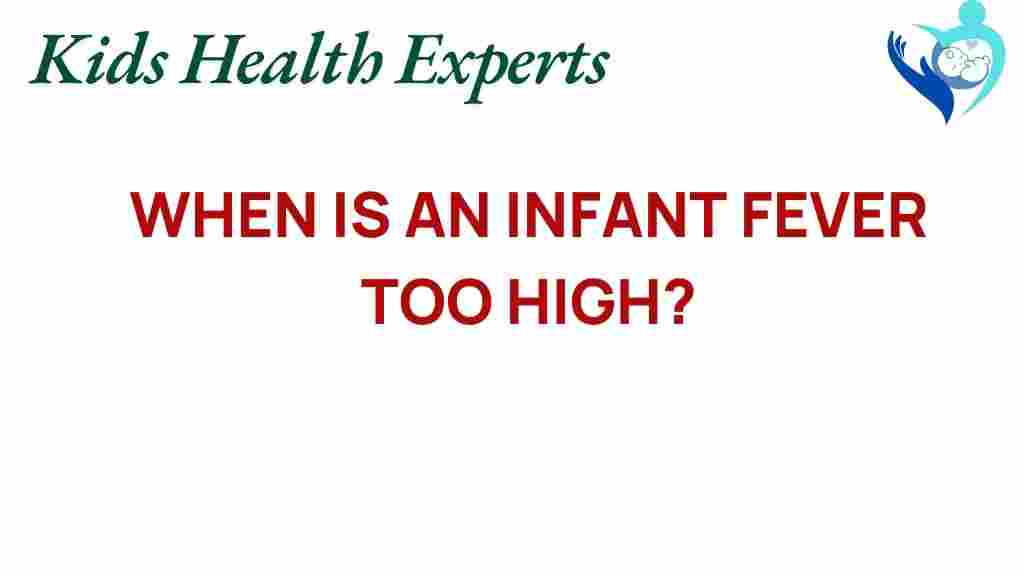As a parent, few things are more concerning than seeing your infant unwell. One of the most common issues that can arise is an infant fever, which often raises questions about its severity and when to seek help. Understanding high fever in infants is crucial for effective pediatric care. This article will guide you through recognizing symptoms, managing fever, and knowing when it’s time to consult a healthcare professional.
Understanding Infant Fever
Fever is defined as an increase in body temperature, typically above 100.4°F (38°C). While fever can be alarming, it is often a sign that the body is fighting off infection. In infants, a fever can be particularly worrisome, especially for first-time parents. Here, we will explore the various aspects of infant fever.
Normal Body Temperature Ranges
The normal body temperature for infants can vary based on various factors, including the time of day and how the temperature is taken. Here are the typical ranges:
- Rectal: 98.6°F (37°C) is average, with a normal range of 97.9°F to 100.4°F (36.6°C to 38°C).
- Oral: 97.6°F (36.4°C) is average, with a normal range of 95.9°F to 100.4°F (35.5°C to 38°C).
- Axillary (underarm): 96.6°F (35.9°C) is average, with a normal range of 94.5°F to 99.1°F (34.7°C to 37.3°C).
- Tympanic (ear): 98.6°F (37°C) is average, with a normal range of 97.5°F to 100.4°F (36.4°C to 38°C).
Causes of Infant Fever
Fever in infants can be caused by various factors, including:
- Viral infections (e.g., colds, flu)
- Bacterial infections (e.g., ear infections, urinary tract infections)
- Teething
- Vaccinations
- Heat exhaustion
When is Fever Considered High?
When it comes to infant fever, the term “high fever” typically refers to temperatures above 102°F (38.9°C). However, the context is crucial. For infants under three months, any fever above 100.4°F (38°C) warrants immediate attention from a healthcare professional.
Symptoms to Monitor
Recognizing additional symptoms accompanying a fever can help determine the seriousness of the situation. Common symptoms include:
- Irritability or excessive crying
- Difficulty waking up
- Refusal to feed
- Rash
- Difficulty breathing
- Stiff neck
- Persistent vomiting or diarrhea
Emergency Signs: When to Seek Help
Understanding when a fever becomes a medical emergency is crucial for pediatric care. Parents should seek immediate medical attention if they notice any of the following:
- An infant younger than three months has a fever of 100.4°F (38°C) or higher.
- A fever of 104°F (40°C) or higher in any infant.
- Signs of dehydration (e.g., dry mouth, no tears when crying, fewer wet diapers).
- Severe headache or body aches.
- Unresponsive or excessively lethargic.
- Seizures.
Fever Management: Step-by-Step Process
Managing an infant fever effectively involves a few key steps. Here’s a step-by-step guide to help you through:
Step 1: Measure the Temperature
Utilize a reliable thermometer to check your infant’s temperature. Choose the most comfortable method for your baby, often rectal for the most accurate reading in infants.
Step 2: Keep Your Infant Comfortable
Dressing your baby in lightweight clothing can help them feel more comfortable. Ensure they are not overly bundled, as overheating can worsen fever.
Step 3: Offer Fluids
Increase fluid intake to prevent dehydration. Offer breast milk, formula, or water (for older infants). Monitor for signs of dehydration as mentioned earlier.
Step 4: Use Fever Reducers If Appropriate
If your infant is uncomfortable, you can consider administering fever-reducing medication. Acetaminophen is generally safe for infants over two months old, while ibuprofen can be given to those over six months. Always consult your pediatrician before administering any medication.
Step 5: Monitor Symptoms
Keep a close watch on your infant’s symptoms. If the fever persists for more than 24 hours or worsens, contact your healthcare provider.
Troubleshooting Tips for Parents
As a parent, you may encounter various scenarios while managing your infant’s fever. Here are some troubleshooting tips to help guide you:
- If the fever doesn’t respond to medication: Contact your pediatrician for guidance.
- If your infant is lethargic: Seek immediate medical attention.
- If your baby’s fever is accompanied by a rash: Consult a healthcare provider to determine the cause.
- If you’re unsure about dosage: Always double-check with your pediatrician or pharmacist.
- If your baby has recently been vaccinated: Fever can be a normal side effect, but monitor for unusual symptoms.
Parental Guidance: Trust Your Instincts
As a parent, trusting your instincts is vital. If you feel something is wrong or your infant’s condition seems to be worsening, do not hesitate to seek medical advice. Your intuition plays a crucial role in managing your child’s health.
Conclusion: Prioritizing Child Health
Understanding infant fever and knowing when a high fever requires medical attention is essential for ensuring your child’s health and well-being. By being informed about fever management, symptoms, and emergency signs, parents can navigate this common concern with confidence. Always remember that your pediatrician is a valuable resource, and don’t hesitate to reach out for help when needed.
For more information on child health and fever management, visit this resource or consult with your pediatrician. Taking proactive steps in managing your infant’s health can lead to better outcomes and peace of mind for parents.
This article is in the category Care and created by KidsHealthExperts Team
